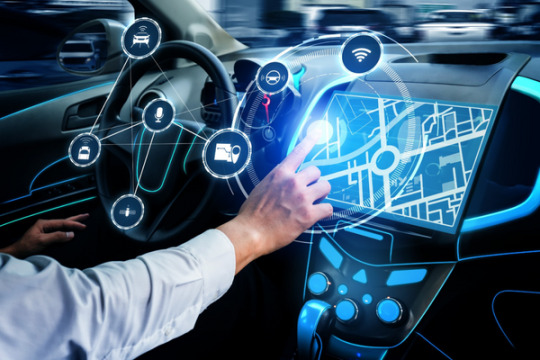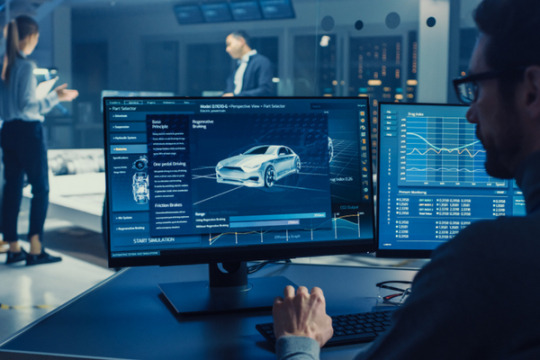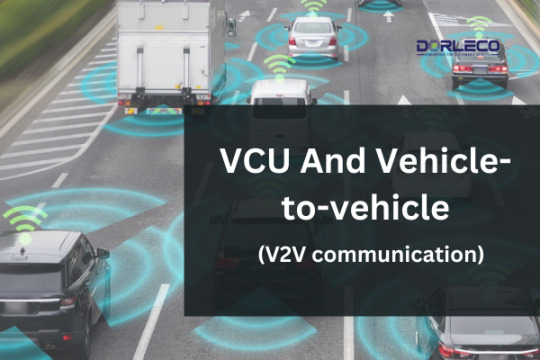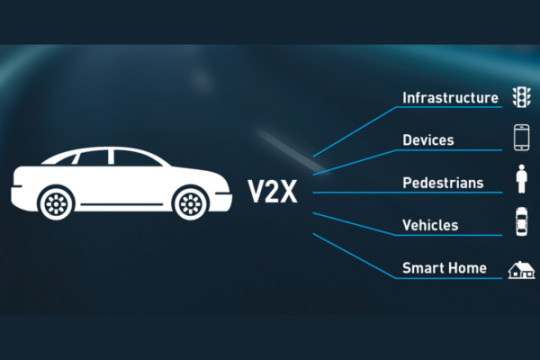#VCUsinElectricvehicle
Explore tagged Tumblr posts
Text
Traffic Management With Advanced Driver Assistance Systems (ADAS)
April 24, 2024
by dorleco
with no comment
Autonomous Vehicle Technology

Introduction
As the world becomes more urbanized, traffic congestion has become a serious issue for both commuters and city planners. When population density and the number of vehicles on the road increase, traditional traffic control strategies might not be adequate on their own. It is now acknowledged that Advanced Driver Assistance Systems (ADAS) have the potential to completely transform traffic management.
This blog article will look at how ADAS can improve traffic management, enhancing road effectiveness and safety while reducing the harmful consequences of traffic congestion on the environment:
1. The Growing Difficulty of Traffic Management
Growing urbanization has made traffic congestion a major issue in major cities across the globe. Congested roads result in longer commutes, higher fuel expenses, more pollution, and lower productivity. Conventional traffic management methods have prioritized road extensions, traffic signals, and infrastructure enhancements. Given the limitations of present solutions, a more comprehensive approach is needed to solve the complexity of today’s traffic challenges.
2. Advanced Driver Assistance Systems Overview

The goal of Advanced Driver Assistance Systems is to improve vehicle safety by incorporating a range of technologies. ADAS provides real-time information about the vehicle’s surroundings through the use of sensors, cameras, radar, and communication. Typical ADAS features include cooperative adaptive cruise control (CACC), intersection management, traffic jam assistance (TJA), and adaptive cruise control (ACC).
3. ADAS and traffic management working together
Advanced Driver Assistance Systems has several innovative features that could significantly enhance traffic management.
Adaptive Cruise Control (ACC): This feature keeps a safe following distance between cars by automatically adjusting the speed of the car in response to traffic flow. Because of this, there are fewer stop-and-go traffic patterns, which improve traffic flow and reduce congestion.
Traffic Jam Assist (TJA): TJA allows for semi-autonomous driving in crowded places by combining adaptive cruise control (ACC) and lane-keeping assistance (LKA). Through assistance with steering, acceleration, and braking, TJA relieves the strain that comes with constantly stopping and starting in traffic. This feature can significantly improve traffic flow and reduce the likelihood of collisions.
Intersection Management: Advanced Driver Assistance Systems can enhance traffic flow at intersections by utilizing vehicle-to-vehicle (V2V) and vehicle-to-infrastructure (V2I) communication. Cooperative intersection collision avoidance (CICA) systems can be used to coordinate vehicles approaching a junction, reducing the likelihood of collisions and increasing traffic efficiency.
Adaptive Cruise Control with Cooperation (CACC): By enabling communication between platoons of vehicles, CACC expands the potential of ACC. Owing to the constant speed, automobiles can approach one another while maintaining a safe distance. CACC can reduce traffic and increase road capacity, especially on highways.
Predictive traffic management: Using machine learning algorithms and real-time traffic data, certain ADAS systems predict traffic patterns and congestion. This enables proactive traffic management strategies, such as dynamic rerouting and signal optimization, to lessen traffic congestion before it gets worse.

4. ADAS’s advantages for traffic management
ADAS integration in traffic management has several benefits, such as:
Safer roads: Advanced Driver Assistance Systems technology, such as junction management and collision avoidance, can significantly reduce the frequency of accidents on the road, making it safer for all users.
Reduced Congestion: By facilitating smooth traffic flow, ACC and TJA can reduce congestion, resulting in shorter travel times and lower fuel use.
Environmental Impact: By alleviating traffic congestion and promoting smoother driving patterns, ADAS helps reduce greenhouse gas emissions and other pollutants associated with stop-and-go traffic.
Enhanced Productivity: Businesses and people alike benefit from shorter travel times and less time spent stalled in traffic.
Optimal Resource Utilization: By enabling traffic management, Advanced Driver Assistance Systems can prolong the useful life of existing roadways, preventing the need for costly road expansion projects.
5. Connectivity and Data Sharing’s Role
For ADAS systems to function, networking and data sharing between vehicles and infrastructure are essential. Cooperative ADAS components like CACC and intersection management depend on dependable V2V and V2I communication. V2X (vehicle-to-everything) communication advancements and 5G network development are critical to achieving the full potential of ADAS in traffic management.
6. Obstacles and Prospects
Although advanced driver assistance systems have great promise, there are still challenges that need to be solved before they can be extensively utilized and successfully incorporated into traffic management:
Infrastructure Improvements: The implementation of V2X communication calls for significant infrastructure upgrades and financial investments in intelligent transportation systems. Cyber security issues: With ADAS systems becoming more networked, there’s a higher likelihood that vehicles and transportation infrastructure may fall victim to cyber-attacks, which makes effective cyber security measures imperative.
User Acceptance and Education: Users need to be informed about and receptive to Advanced Driver Assistance Systems for them to be extensively adopted. Drivers need to understand the advantages and disadvantages of these technologies to use them safely and effectively.
Data Privacy: Concerns about data privacy and ownership are raised by the sharing of real-time traffic statistics. Finding a balance between data exchange for traffic management and privacy protection is crucial.
Interoperability: It is necessary to guarantee interoperability across different Advanced Driver Assistance Systems technologies and vehicle models to fully utilize the benefits of these systems throughout the entire fleet of cars.

Conclusion
In conclusion, advanced driver assistance systems (ADAS) can completely change traffic management by increasing safety, reducing congestion, and minimizing the negative environmental effects of traffic congestion. Features including predictive traffic management, intersection management, ACC, TJA, and CACC hold the key to a more efficient and eco-friendly transportation system.
Resolving infrastructure, cyber security, user acceptability, and data privacy concerns is critical to ensuring that Advanced Driver Assistance Systems are seamlessly incorporated into traffic management processes. The vision of an intelligent, networked transportation system driven by ADAS is becoming closer to reality as technology advances, improving the safety, efficiency, and environmental quality of our roads for the coming generations.
#VCU#ADAS#FutureOfMobility#AutonomousDriving#VCUSupplier#VCUManufacturer#Dorleco#VCUsinElectricvehicle
0 notes
Text
VCU And Vehicle-to-vehicle (V2V communication)
April 23, 2024
by dorleco
with no comment
Autonomous Vehicle Technology

Introduction to V2V communication
Vehicle Control Units (VCUs) and Vehicle-to-Vehicle (V2V) communication are key components in forming this revolutionary environment as the automotive industry moves closer to a future of linked and autonomous vehicles. Modern cars’ brains, or VCUs, perform several vital tasks. Additionally, vehicle-to-vehicle (V2V) connectivity enables vehicles to share real-time data, enhancing overall driving pleasure, efficiency, and safety.

1. The Evolution of Control Units for Vehicles
Vehicle control units, or VCUs, are now integral components of modern cars, serving as the hub for a variety of vehicle operations. VCUs evaluate data from several sensors and systems, enabling flawless coordination of powertrains, brakes, steering, and other systems. As technology has advanced, VCUs’ ability to incorporate more complex functions has expanded, making them crucial elements in the integration of cutting-edge technologies like autonomous driving and vehicle-to-vehicle communication.
2. Comprehending Communication from Vehicle to Vehicle (V2V)
Real-time data transmission between moving automobiles is known as car-to-car (C2C) communication, often referred to as vehicle-to-vehicle (V2V) communication. Through this wireless data interchange, vehicles can exchange information about their position, speed, direction, acceleration, and brakes. By creating a network of connected automobiles that can “talk” to one another, vehicle-to-vehicle communication significantly improves both traffic efficiency and road safety.
3. The Vehicle Control Units (VCUs) and V2V Communication Technology VCUs:
Vehicle Control Units (VCUs): VCUs rely on powerful microprocessors and complex software algorithms for their technology. A vehicle’s sensors, cameras, and radars are just a few of the parts that provide input to VCUs. They process this data to expedite decision-making, enhance vehicle performance, and safeguard occupants and other road users.
Dedicated Short-Range Communication (DSRC): The primary technology used for V2V communication is DSRC, also referred to as Dedicated Short-Range Communication. It works on a certain frequency spectrum and enables fast and secure data transfer between cars within a given range, often a few hundred meters. DSRC guarantees low latency, allowing real-time communication for critical safety applications.
Cellular Vehicle-to-Everything, or C-V2X: Another V2V communication technique called C-V2X transfers data across existing cellular networks. Its advantages include the capacity for over-the-air software updates, a larger connection range, and higher data speed. More sophisticated V2X applications, like communication between cars and infrastructure (V2I) and pedestrians (V2P), may be made possible by C-V2X in addition to V2V.
4. The Role of VCUs in V2V Communication
To make vehicle-to-vehicle (V2V) communication possible, VCUs are necessary. They act as the central point for managing and connecting V2V data to other car systems. The VCU receives V2V signals, processes the data, interprets it, and makes decisions based on data from neighboring automobiles. These options include changing the speed of the car, applying the brakes, or warning the driver.

5. Advantages of V2V Communication Enabled by VCUs Enhanced Security:
Cars can communicate about intentions such as lane changes and sudden braking through vehicle-to-vehicle (V2V) communication. This common knowledge reduces the likelihood of accidents and improves overall road safety by enabling automobiles to anticipate and respond to potential dangers.
Crossroads Safety: V2V communication facilitates better traffic flow and reduces congestion at intersections by enabling cars to share information about their positions and intentions. For example, vehicles can cooperate to determine the most efficient paths through intersections without the assistance of traffic signals.
V2V communication helps drivers prevent collisions by alerting them to any hazards that might be out of their direct line of sight. When faced with an emergency, V2V-enabled vehicles can take proactive steps to avoid collisions, such as autonomous emergency braking.
Traffic Efficiency: Vehicle-to-vehicle (V2V) communication can enhance traffic flow by synchronizing vehicle speeds and merging patterns. Because of the decrease in traffic and increase in fuel efficiency, this is advantageous to both drivers and the environment.
Coordination of Emergency Services: In the event of an accident or emergency, vehicle-to-vehicle communication can alert nearby vehicles and emergency services, guaranteeing prompt assistance and swift action.
6. Integration Challenges between VCU and V2V
Even though combining VCU and V2V communication has many advantages, there are a few problems that still need to be fixed:
Standardization: The success of V2V communication depends on a standardized communication protocol. A network needs to be compatible with many automakers and V2V technologies to function well. Cybersecurity and data privacy are problems brought about by the combination of VCUs and V2V communication. Ensuring secure communication links and protecting V2V data from unauthorized access or change is imperative.
Infrastructure Requirement: For V2V communication to be widely used, a sizable and comprehensive infrastructure — including cellular networks and roadside units — is needed. The development and implementation of such infrastructure can present financial and logistical challenges.
Acceptance by Drivers: Drivers must understand and be able to accept vehicle-to-vehicle communication. Drivers need to trust the technology and be ready to cooperate with other linked cars for the system to work.
7. Real-world implementations and Prospects
There are now multiple pilot programs for V2V communication using VCUs in various parts of the world. Several countries, including the US, Japan, and Europe, have conducted successful trials of V2V communication, and these areas are currently actively exploring its possible benefits.

Conclusion
Integrating Vehicle Control Units with Vehicle-to-Vehicle communication is a critical first step toward a safer, more efficient, and networked transportation future. The VCUs found in modern cars act as the brain, enabling fast decision-making and the synchronization of essential vehicle functions. When V2V communication is used, vehicles can communicate, share information, and convey intentions with one another while moving in a safe and tranquil environment.
As VCU and V2V technologies develop, they can completely transform driving experiences for people worldwide, enhance traffic flow, and redefine road safety. To fully reap the benefits of VCU and V2V integration, cooperation between industry players, lawmakers, and researchers is required to resolve issues and pave the road for a smooth and intelligent transportation environment.
Write to [email protected] to learn more about our software development capabilities for battery-specific requirements and to have a look at our top-notch VCU goods and services if you’re searching for the best VCU manufacturer and supplier with VCU testing and validation.
#VCU#V2VCommunication#FutureOfMobility#AutonomousDriving#VCUSupplier#VCUManufacturer#Dorleco#VCUsinElectricvehicle
0 notes
Text
VCU Testing And Validation
April 22, 2024
by dorleco
with no comment
Autonomous Vehicle Technology

Introduction
VCU Testing And Validation

In the rapidly evolving field of automotive technology, manufacturers and suppliers of vehicles are constantly coming up with new ideas to enhance performance, safety, and economy. One of the key components in charge of managing these advancements is the Vehicle Control Unit (VCU). As the brains of the car, the VCU processes data from several sensors and systems to control essential functions, including steering, brakes, and propulsion.
Given the significant hazards involved, the significance of VCU testing and validation in ensuring the dependability and safety of contemporary cars cannot be overemphasized. This blog examines the importance, challenges, and VCU testing and validation methods.
What is a vehicle control unit (VCU)?
The Vehicle Control Unit (VCU), sometimes known as the Electronic Control Unit (ECU), is a vital electronic part that oversees and controls several vehicle subsystems. The vehicle communication unit (VCU) gathers data from various sensors located throughout the vehicle, such as wheel speed, engine, and brake pressure sensors. With the use of this data, the VCU may make snap judgments that improve vehicle performance, safety, and fuel efficiency.
1. The importance of VCU Testing And Validation

VCU validation and testing are crucial processes that guarantee a car will run efficiently and safely. Robust techniques for testing and validation are necessary for the following reasons: Guaranteed security and safety are the top priorities when it comes to autos.
VCU testing ensures that safety-critical components such as anti-lock braking systems (ABS), traction control systems (TCS), and electronic stability control (ESC) function flawlessly. Validation demonstrates the VCU’s ability to react to possible threats in a way that prevents mishaps and safeguards pedestrians and passengers.
Adherence to regulations: The regulatory bodies overseeing the automotive sector establish stringent emissions, safety, and performance benchmarks. Vehicle compliance testing and validation (VCU) enables manufacturers to obtain the necessary certifications and approvals for their products by confirming that automobiles adhere to these standards.
Strength and Reliability Modern cars are subjected to harsh environmental conditions and heavy use. VCU testing shows the control unit’s resilience and dependability in the face of extreme temperatures, vibrations, and electrical disruptions, ensuring consistent functioning throughout the vehicle’s life.
Enhancement of Performance Vehicle performance optimization requires VCU testing. By analyzing data and doing simulations, manufacturers may maximize power delivery, reduce fuel consumption, and enhance overall drivability.
2. Difficulties in VCU Testing and Validation
VCU testing and validation pose several challenges that need to be carefully considered to assure accuracy and efficacy, such as the complexity of the System Modern cars are made up of several interconnected systems, each with a distinct purpose. Testing also includes addressing any potential problems and confirming the VCU’s interoperability with other subsystems.
It might be challenging to replicate real-world situations in simulators of the real world for testing. Complex simulation software and technologies are sometimes required for VCU testing to replicate different driving conditions, traffic scenarios, and potential crises.
As connected cars become increasingly common, worries about cyber security are becoming more and more pressing. VCU testing needs to focus on locating and blocking potential cyberattacks that can compromise data security and vehicle safety. Continual Updates Car software is updated frequently to fix bugs and enhance functionality. VCU testing techniques must take these changes into account to ensure compatibility and simple interaction with the existing systems.
3. Procedures for VCU Testing

Examination of Components Component testing comprises evaluating the performance of each VCU subsystem separately. Because of this, producers may find and address issues specific to each part before adding them to the system as a whole.
Hardware-in-the-Loop (HIL) testing. Real VCU hardware components are tested in HIL in synthetic environments that mimic the vehicle’s surroundings. This technique assesses the VCU’s performance in a range of operating conditions while guaranteeing safety in a controlled setting.
Software-in-the-loop (SIL) testing Software Validation (SIL) testing verifies the VCU’s software performance without utilizing hardware. Computer simulations are used in this testing. The method allows for rapid iterations and refinements of the software before the hardware integration phase.
Transport-in-the-Loop (TIL), A genuine car is equipped with the VCU as part of the VIL testing procedure. This makes it possible to do extensive real-world testing to evaluate the VCU’s performance in various driving conditions.
Conclusion
In conclusion, VCU testing and validation are crucial processes that guarantee the safe and trustworthy operation of modern cars. Manufacturers invest significant time and resources into these operations to ensure regulatory compliance, enhance performance, and, above all, ensure the safety of drivers, passengers, and pedestrians.
The methodology for VCU testing will progress in tandem with the advancement of automotive technology, incorporating innovative approaches to tackle fresh challenges and enhancing driving safety and efficiency for all.
If you are looking for the best VCU supplier and manufacturer with VCU testing and validation, write to [email protected] to find out more about our software development skills for requirements unique to batteries and explore our best VCU products and services.
0 notes
Text
VCU Communication Protocols for Smart Vehicles
April 18, 2024
by dorleco
with no comment
Autonomous Vehicle Technology

VCU Communication Protocols
Introduction
The rapidly evolving branch of automotive technology known as vehicle control units, or VCUs, has assumed the function of the brains of modern cars. These advanced electronic control units oversee and manage several vehicle systems to ensure maximum efficiency, security, and effectiveness.
One key component that makes VCUs function properly is the communication protocols they utilize to communicate with other parts of the vehicle and outside systems.
This blog will go over VCU communication protocols, their use in smart cars, and new concepts that may have an impact on future automotive communication.
The Function of Communication Protocols in VCUs
VCUs are the decision-makers in a vehicle; they gather data from various sensors and control modules and process it before sending commands to engines, actuators, and other components. To facilitate this smooth connection, VCUs rely on communication protocols, which act as a set of rules governing data transmission between various vehicle sections.
Communication protocols enable VCUs to make informed decisions about engine control, stability control, and other vehicle functions based on real-time sensor data, including wheel speed, engine temperature, and steering angle. By enabling connectivity with external systems like entertainment devices, GPS, and connected services, they also guarantee a well-integrated driving experience.
Typical VCU Protocols for Communication
In automotive applications, a variety of communication protocols are commonly used to enable VCU communication. Let’s have a look:
The Controller Area Network (CAN) is one of the automotive industry’s most widely used communication protocols. This reliable and strong link allows data to be transmitted between the numerous electronic control components in the car. CAN operates on a two-wire bus system and offers both high-speed and low-speed communication, making it suitable for a range of applications, such as powertrain control and infotainment systems.
The Local Interconnect Network (LIN) is an alternative communication protocol designed to provide slower data transmission within automobiles. Less important uses for it include window control, seat adjustment, and interior lighting. Because of its price and simplicity, LIN is the best choice for applications where a lot of bandwidth and real-time responsiveness are not required.

2. Flex Ray is a high-speed communication protocol that was created to satisfy the growing demands of complex automotive applications. It is appropriate for fault-tolerant real-time applications and safety-critical systems like adaptive cruise control and active suspension due to its greater bandwidth and fault-tolerant qualities.
3. Ethernet: As cars get increasingly networked and data-intensive, Ethernet is gradually finding its way into the automotive sector. The high bandwidth of Ethernet allows the numerous systems and devices within the car to connect seamlessly. It is possible to incorporate in-car entertainment, high-definition cameras, and advanced driving assistance systems (ADAS).
Protocols for VCU Communication: Problems and Advancements
Despite the significant advancements in VCU communication protocols, some difficulties remain to be addressed to meet the demands of the next generation of smart vehicles:
1. Security: As cars become more autonomous and networked, cyberattacks are increasingly likely to occur. To safeguard vehicle occupant privacy and safety, VCU communication mechanisms must be protected from potential threats. Robust authentication, intrusion detection, and encryption methods will be necessary to safeguard the integrity of data transferred between VCUs and external systems.
2. Scalability: As the number of electronic control units and sensors in cars rises, communication protocols must be able to grow accordingly. Future protocols must be able to handle the increasing volume of data while maintaining high dependability and low latency.
3. Standardization: The automobile sector involves a wide range of partners, including suppliers, technology companies, and manufacturers. Standardizing communication protocols among different automakers and car types will promote innovation and interoperability.

Future VCU Communication Protocols
The following trends will have a positive impact on the automotive industry, meaning that VCU communication protocols have a bright future ahead of them:
1. Adoption of Ethernet: Owing to its large bandwidth, Ethernet will be more prevalent in VCU communication. With the increasing prevalence of sophisticated sensor systems, in-car entertainment, and autonomous driving, Ethernet will provide the necessary infrastructure for seamless data transfer across many systems.
2. 5G Connectivity: The deployment of 5G networks will alter communication at VCU by enabling faster and more dependable data transmission. The low latency and high throughput of 5G will be advantageous for two real-time applications: autonomous driving and V2X (vehicle-to-everything) communication.
3. Time-sensitive applications such as autonomous driving and ADAS can benefit from Time-Sensitive Networking (TSN), an Ethernet advancement that aims to provide real-time capabilities. TSN’s ability to arrange and prioritize data packets will result in rapid and deterministic communication between diverse components.

Conclusion:
To sum up, VCU communication protocols enable efficient data transfer and system coordination, which are the basis of modern smart cars. As automobiles continue to advance with the advent of electrification, autonomous driving, and connected mobility, the necessity for scalable and dependable communication protocols cannot be overstated.
The deployment of TSN, the uptake of Ethernet, the deployment of 5G connections, and the seamless integration of cloud services will all have an impact on VCU’s communication landscape. VCUs will be crucial in determining the direction of the automobile industry and leading us toward a safer, more effective, and more connected future on the roads by fixing the issues and embracing these trends.
If you are seeking a trustworthy VCU supplier or would like to discuss possible partnerships for VCUs, send an email to [email protected].
0 notes
Text
Future Trends In VCUs
April 17, 2024
by dorleco
with no comment
Autonomous Vehicle Technology

Future Trends in VCUs: Overview
The automobile industry has experienced a remarkable shift in the past few years due to technological advancements. One crucial element of this change is the development of Vehicle Control Units (VCUs). These extremely sophisticated electronic control units are necessary to operate a wide range of functions in modern cars, including engine management, entertainment, and safety features. As linked mobility, electrified vehicles, and autonomous driving become closer, significant advancements in VCUs are predicted.
The worldwide market research report on vehicle control units (VCUs) offers a comprehensive analysis that takes into account crucial elements like the total market size, both at the regional and national levels, as well as market share, market growth, an examination of recent advancements, collaborations, and prospects, sales and competitive landscape analysis, anticipated product launches, technological innovations (both completed and in the works), and market share figures.
This blog looks at the new future trends in VCUs that are going to change the way we use and interact with cars:

1. Greater use of artificial intelligence (AI) integration
Artificial intelligence will be the foundation of future virtual colleges. Machine learning and deep neural networks are two examples of AI technologies that VCUs can integrate to optimize vehicle performance based on real-time data. VCUs will be able to learn from environmental elements, traffic patterns, and user preferences with the aid of AI. This will lead to better fuel efficiency, preventive maintenance, and customized driving experiences. AI-powered VCUs will enable autonomous cars to make split-second choices while ensuring the safety of their passengers.
2. Real-time processing using Edge Computing
As vehicles become more and more linked, a vast amount of data is being produced by their numerous sensors and communication systems. Real-time analysis of this data is necessary for responsive and intelligent vehicle control. Future VCUs will process data closer to their source using edge computing, reducing latency and providing faster reaction times. This will be crucial for autonomous vehicles in particular, as they must be able to make snap decisions to navigate difficult situations.
3. Cybersecurity & Over-the-Air (OTA) Updates
Future trends in VCUs will be dynamic platforms with remote upgradeability rather than static systems. OTA updates will alter car maintenance by allowing manufacturers to patch bugs, add new features, and improve performance without requiring customers to physically visit service facilities. With increased connection, cyber-attacks are still a possibility. Cyber security will be a top priority for VCU developers to protect cars and passengers from danger and to uphold the integrity and safety of the VCU ecosystem.
4. V2X Interaction for Increased Road Safety

In the future, mobility progress will be dependent on V2X communication. By enabling vehicles to communicate with people, the environment, and other vehicles, VCUs can enhance situational awareness and avoid accidents before they happen. Features enabled by V2X communication, such as Pedestrian Detection, Emergency Vehicle Signal Priority, and Intersection Collision Warnings, will make our roads safer and more efficient.
5. Energy Efficiency and Electrification
With the increasing focus on sustainability and the transition to electric cars (EVs), VCUs will be critical to optimizing energy efficiency. To extend the range and overall efficiency of EVs, advanced VCUs will handle motor control, battery performance, and regenerative braking. Furthermore, VCUs will collaborate with renewable energy sources and smart grids to smoothly incorporate clean energy into the transportation environment.
6. Customization and User Interface
Future trends in VCUs will prioritize user experience and customization, making it possible to customize the driving environment to suit personal tastes. Thanks to VCUs, which provide customized infotainment settings, climate control, and adaptive driving modes, each passenger will have a unique and enjoyable driving experience. As part of this increased personalization in autonomous driving, passengers will be able to choose from a range of autonomous driving modes according to their tastes and level of technological comfort.
7. Heads-up displays (HUDs) and augmented reality (AR)

The way drivers engage with their vehicles will fundamentally change with the introduction of AR technology into VCUs. Augmented reality-enabled heads-up displays will project important information straight into the driver’s field of vision, reducing distractions and enhancing safety. For example, drivers can get instructions while maintaining eye contact with the road thanks to roadside projection of AR navigation directions.
Conclusion
The future trends in VCUs are extremely bright, with developments in artificial intelligence, connectivity, energy economy, and user experience poised to dramatically revolutionize the automotive industry. As VCUs become smarter, more networked, and more secure systems, they will usher in a new era of smart mobility.
The idea of fully autonomous, electrified, and connected cars will become a reality with the integration of cutting-edge technologies into VCUs, improving road safety, environmental sustainability, and overall driving pleasure for all.
Send an email to [email protected] if you would like to talk about potential partnerships for electronically-controlled VCUs.
0 notes